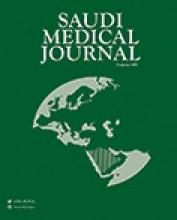Abstract
OBJECTIVE: To determine the prevalence of vitamin D deficiency in healthy Saudi adults.
METHODS: A cross-sectional study carried out as part of the screening and early evaluation of kidney disease project. Vitamin D was measured in subjects recruited at 2 screening camps in Riyadh, Saudi Arabia, between March to May 2008. Subjects from the 2 large commercial centers in Riyadh aged >/=18 years and Saudi nationals were invited.
RESULTS: The study sample comprised of 488 subjects. The mean age of the subjects was 37.43 (11.32) years, of which 50.2% (n=245) were males. Twenty-nine percent of subjects were in the vitamin D deficiency group, 22.7% were in the relative insufficiency group, and 47.5% had normal levels of 25-hydroxy vitamin D. We observed that female gender was an independent predictor of vitamin D deficiency or insufficiency (odds ratio [OR]: 2.992; 95% confidence intervals [CI] 2.069-4.327). Anemia was also a predictor for vitamin D deficiency or insufficiency (OR: 3.16; 95% CI 2.02-4.92). Age was positively correlated with vitamin D levels (Pearson correlation=0.183, p<0.000).
CONCLUSION: Vitamin D deficiency is common in healthy Saudi adults. This is more pronounced in females and in the younger age groups. Wearing of traditional clothes, deliberate avoidance of the sun, and inadequate dietary intake are likely to be the principal causes of low vitamin D levels.
- Copyright: © Saudi Medical Journal
This is an open-access article distributed under the terms of the Creative Commons Attribution-Noncommercial License (CC BY-NC), which permits unrestricted use, distribution, and reproduction in any medium, provided the original work is properly cited.






